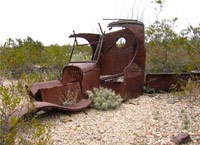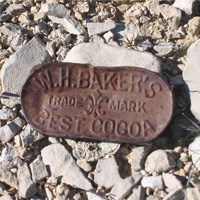
NPS Photo/Sharon Collyer Each year, park visitors bring in things that they think are important and want to “show a ranger” what they found. Each year, some well-intentioned visitor will “clean up a trash pile” and deposit it on our doorstep. The question continues to arise whether or not piles of rusty tin cans and broken bottles are important artifacts. First, these items really are government property. Even the stuff in our landfill is government property. The Code of Federal regulations is quite specific about protecting government property and park resources in general from disturbance of any kind. In that sense, they are important and our law enforcement responsibility is to deal with each case independently according to its severity. Context MattersArchaeological and historic sites contain artifacts that tell a story of how people used that location on the landscape. The association of an artifact to a location, or context, is directly linked with the human activities on the site. Knowing the context of the object is crucial to determining what human activities took place on the site, why this object was used there, and how it ended up in the place and condition in which it is found. When the inhabitants are no longer around to ask, the only way to determine and interpret the questions of "what, why, and how" lies in finding and recording the context, as well as in recovering the objects. In fact, the context is more important than the object itself. Only someone trained in identifying the age of items in a trash pile is really able to distinguish between something significant and something that belongs in the landfill. I have looked over numerous piles of cans, bottles, broken pottery, wire and miscellaneous metal over the past twenty plus years and have yet to find something in the pile that can’t tell me how old the stuff is, or more importantly, learn something about the people who lived on the site from the things they left behind. The importance is the context from which the objects came. If we lose the context, then we probably do have just a pile of trash. Some examples are provided in the following pages to illustrate these points. A pile of cans collected from the Solis vicinity contained some unique cone-top soda pop cans that were only produced by a single bottling company during a very short three-year period in the 1950s. Knowing where these cans were found gave us about a ten-year period of occupation for the ruin nearby. Knowing the context of this trash pile turned out to be important historical and archeological information. Without that information, we cannot effectively assess the importance of the find. After all, one day, our trash will be considered artifacts representing how we dealt with our environment. 
NPS Photo/Sharon Collyer When a visitor proudly brings in an object to "show a ranger," it places a burden of responsibility upon us to properly care for that object. First, its context must be recorded. It must be photographed, cleaned, stabilized, and curated. A museum accession record must be made of it that includes noting the context from which was obtained. It must be labeled with the accession number and the number of the site from which it came. If the site has not been documented, someone has to go there and record the site, map it and identify its important features, and those records must than be placed in the park files. This involves much time by several people. This simple object brought in by a visitor, or an employee, can cost the park anywhere between $50 and $150 just to get it into the museum collection. If it requires recording a new site, the cost can literally run thousands of dollars. So, it is important that people understand the complexity created by the simple act of bringing in an artifact. |
Last updated: September 18, 2017
